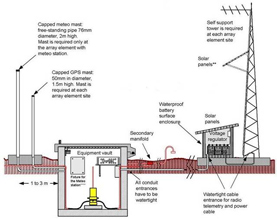ARISE technologies
Infrasound network
Infrasound technology using micro-pressure sensors (microbarometers) has been experimented for a long time, but sensors were often isolated, and it was only possible to extract and analyze the largest disturbances from the ambient infrasound noise. The introduction of arrays opened up a whole range of possibilities for this technology. However, measurements were too rare to provide a significant input for a atmospheric studies. All the technical aspects of infrasound monitoring have been redeveloped for CTBT verification. Approximately 42 stations of the IMS (International Monitoring System) network with global and homogenous coverage and unique data quality have been recently installed changing our vision of the atmosphere. When completed the network will include 60 stations. It allows infrasound observations with an unprecedented precision, thanks to the use of a large number of arrays of sensors uniformly distributed throughout the world. It is dedicated to be in operation over a very large period of time. Its potential for imaging the atmosphere is high and it opens many scientific studies in relation with atmosphere and climate.

Detections of the Russian Fireball (2013/02/15) by the 42 IMS network stations available today, P. Mialle, Infrasound technological workshop, 2013
In Europe, the IMS stations complemented by national stations are used to continuously monitor the infrasound activity over the continent.
The infrasound arrays are very sensitive acoustic antennas, which are able to detect and characterize any coherent infrasound signals. Since 2000 an improvement of signal-to-noise ratio (SNR) of up to 50% at many infrasound stations has been achieved due to technical factors such as optimized array design, introduction of higher standards for grounding, use of wind-noise reduction devices. The large dynamics of the instruments allow the observations of both very strong events close to the station and very small ones at distances of a few thousand kilometres. In the last decade, detection bulletins determined from the daily data analysis have been produced by an increasing number of institutes and correlated with observations of natural or man-made atmospheric sources, such as exploding meteoroids, volcanic eruptions, hurricanes, earthquakes and ocean swell.
The growing amount of infrasound data has been challenging for the different institutes in terms of station and network processing, who had to rethink and redesign the way infrasound data are processed: Enhancement of automatic signal detection algorithms using cross correlation techniques, introduction of methods for associating the detected signals, and determination of the source location.
Infrasound (and related studies) is a young scientific topic. The large potential of infrasound data for scientific and civil applications has been successfully demonstrated during many international meetings American Geophysical Union (AGU), European Geosciences Union (EGU), International Union of Geodesy and Geophysics (IUGG), Acoustical Society of America (ASA), Infrasound Technology Workshop (ITW). Results were published in the Springer book: "Infrasound monitoring for atmospheric studies" (6900 chapter downloading in 2013) and more than 20 scientific papers published the last 2 years.

 ARISE Home
ARISE Home ARISE Data Center
ARISE Data Center
